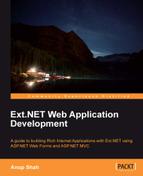In this chapter we had a look at how Ext.NET and Ext JS provide layout capabilities. While Ext.NET provides many layouts we saw a few in detail here:
- Border layout
- Accordion layout
- Fit layout
- HBox layout
- VBox layout
The Border layout demonstrated both the power of that particular layout but also the flexibility in Ext.NET in terms of how to define and use it. We saw that we can also nest Border layouts, and when we looked at the Accordion layout we also saw that a combination of layouts is easily possible. The Fit layout demonstrated how you can get something to fit the container and stretch with it whenever the container is resized. With HBox and VBox layouts we saw powerful options to configure items in numerous ways horizontally and vertically. In addition, we saw they could be combined to help center a component which is quite a popular thing to do.
We also looked at the Viewport as another example of a container which is frequently used in conjunction with a layout to create an application look and feel for your web page. But we also saw that layouts can be applied to other containers, such as Panels and Windows. Finally, we noted that Panels are not the only items taking part in layout. Other components such as TabPanel and TreePanel can be directly used in place of a Panel (as they are subclasses of Panel) which helps create more reusable and lean applications, instead of embedding and deeply nesting Panels everywhere. Another powerful Panel subclass is a GridPanel which can also be used directly instead of a Panel. But before we look at the GridPanel we will introduce some other powerful features of Ext.NET. The next chapter looks at how AJAX works with Ext.NET.
